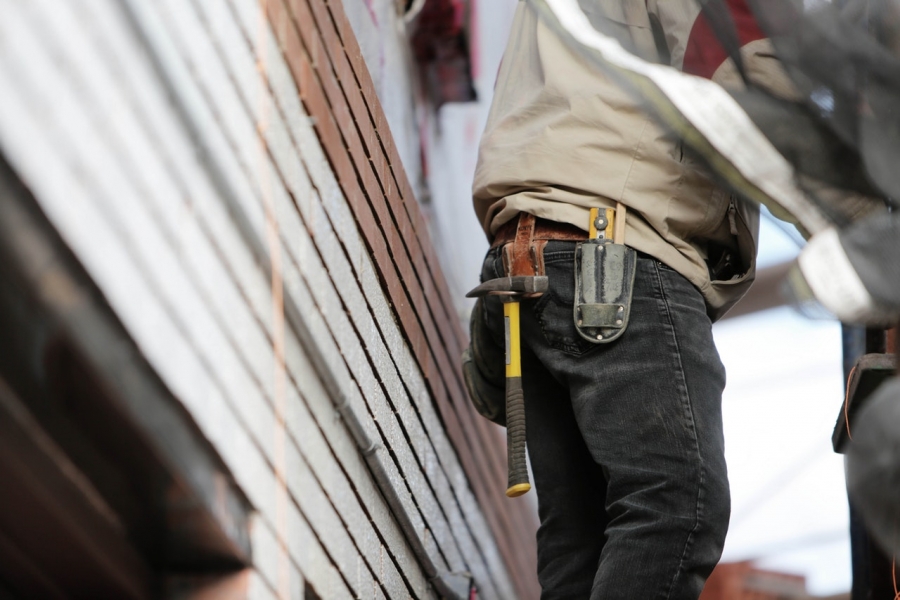Whether you're a contractor or a homeowner, you're going to be finishing — or starting — some home projects this winter. Winter is a surprisingly suitable time for home improvements. You get discounts on tools due to the holiday season, and you can complete repairs in time for the sun-and-fun months.
Some regions don't get snow in the winter, but if yours does, you'll benefit from implementing a few safety measures before starting on the next task. Protecting yourself during the winter requires extra care to ensure an enjoyable experience.
Luckily, this is easy to accomplish with some simple tips. Check out these seven safety guidelines for tackling home projects in the cold months.
1. Clear the Walkways
Clear your driveway, patio and other hardscaping of snow and ice before you start any outdoor activities. Both of these can create a dangerous slipping hazard, especially since ice isn't always visible.
If you don't want to clear all your walkways, do the sections where the most walking occurs. A snow- and ice-free path means no unexpected hospital trips or embarrassing moments.
After you remove the snow, lay sand or salt across the pathway. You can even try cat litter in the absence of other materials.
2. Practice Caution When Shoveling Snow
Snow shoveling can put a lot of strain on the body. It's necessary for keeping your walkways safe, but practice caution to avoid injury. Lift the shovel with your knees instead of your back, and don't overfill it. When you first begin shoveling, try pushing the snow instead of lifting it to warm yourself up for the main event. And whenever you feel tired, go inside and take a break instead of powering through it.
A study of citizens in Quebec, Canada, showed that shoveling snow could increase the chances of having a heart attack, especially in men. Avoid overtaxing yourself — enlist additional help if needed.
3. Preserve Warmth With Protective Gear
Wearing the right gear will keep you safe and prevent you from freezing in extreme temperatures. Buy boots with a solid tread and enough traction to prevent slipping on ice or snow. Gloves, coats, hats and more should be well-insulated and waterproof — no one needs a nasty case of frostbite.
More involved projects require some extra gear on top of the warm layers. Bring along gear like goggles, hard hats and face masks. The right mix of protective wear will establish a barrier from infection, particulate matter, biohazards and more.
4. Properly Ventilate Your Home
If you're a homeowner, ensure your house has proper ventilation throughout the winter. Indoor home improvement projects can leave pollutants like chemicals or dust in the air. Since you'll be spending a lot of time inside, you don't want to be breathing in this unclean air all day.
Change your air filters and clean out your exhaust fans to reduce the debris. Dust and vacuum regularly, and wipe down the walls and other surfaces to remove particles.
5. Care for Your Tools
Maintain your tools year-round. Receiving injuries from instruments that are uncared for and falling apart is commonplace. If something starts wearing out and is beyond the point of fixing, replace it. Your lucky hammer or drill can only provide so much value after it reaches the end of its use.
Clean and store your supplies properly when you finish with them. Keep your tools away from condensation or humidity — you risk rust, which can shorten their lifespan and effectiveness.
A bucket of sand and vegetable oil can provide a quick way to eliminate dirt and protect the finish of your equipment.
6. Keep a First-Aid Kit
Accidents happen — bring a first-aid kit with you to treat any injuries. Stock up on essentials like gauze, rubbing alcohol, bandaids, ointment and more. First-aid kits are easy to buy and come filled with the proper supplies, but you can always create your own.
Include medications like cough, cold and flu remedies and pain relievers. Hopefully, you won't have to use them, but it's better to have them already on hand if you catch a bug.
7. Remove Icicles
Falling icicles are a safety hazard, especially when they're massive. If you see small, easily accessible ones around the home, remove them from the gutters and roof with a long object like a rake. Stand to the side when knocking them down. Don't use a ladder to reach the higher ones — you can sustain severe injuries if you fall.
If the icicles are too large or high up to knock down, let them melt. Deter anyone from standing under them in the meantime.
Break Out Your Winter Design Plans
Stay safe during your winter projects so you can enjoy the fruits of your labor during spring. You'll be in good health to take on even more exciting assignments throughout the warm months. It takes little effort to squeeze in some new safety practices, and they pay off by preventing harm.

